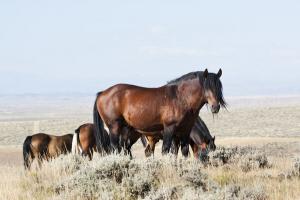LOS ANGELES, CALIFORNIA, UNITED STATES, September 25, 2023 /EINPresswire.com/ -- One day, free-roaming horses grazed peacefully on Wyoming Tribal Land. The next day, they were gathered by plane and helicopters, run for miles then disbanded from their family groups.
Tribal horses were gathered during foaling season. Families were separated into 3 groups: stallions, mares and foals. Kill pen rescue sites reported on social media around 600 stallions were sold to Mexican rodeos for use in horse tripping events. This is a barbaric and inhumane crippling practice that most often leads to death.
It is believed mares shipped straight to slaughter and the foals, ranging in age from 1 week and older, were sent to kill pens across mid-America. Approximately 300 of them were adopted by individuals, rescues and sanctuaries. Many of the very young did not survive the round ups, transportation and kill pens because of dehydration, injury and disease. They were commercialized as weanlings.
The horse slaughter connection to horse tripping, referenced above, is explained in link [1]. An excerpt reads, ‚ÄúOne source of horses for leasing to charro rodeos is feedlots. Kill buyers employed by slaughterhouses lease out horses for the charreada circuit to make extra money from them before selling the horses to horse slaughter plants.‚ÄĚ
‚ÄúBefore they banned horse tripping in California, a source at a Riverside feedlot reported they leased 25 horses per weekend to two different charro rodeos. Upon their return, approximately 2 to 5 horses per week displayed injuries serious enough that the animals were sent to slaughter. For each horse that went to slaughter, another from the feedlot replaced them on the charro circuit. During that season, 75 to 100 horses were leased from that lot to the two charro rodeos, but only 2 of the original horses survived until the season‚Äôs end.‚ÄĚ
The reported slaughter of free-range horses from the Wind River Reservation is a travesty. The horses are an important part of all tribal culture. It is believed thousands of horses from the Wind River Reservation have shipped to their deaths in Mexican slaughterhouses. Horse slaughter is not humane euthanasia, good management or stewardship. The 2023 Large Funding Project is sponsored by the Select Natural Resource Funding Committee. Funding plans for this are expected to carry on into 2024. [2]
Many Americans don‚Äôt know ending horse slaughter is a top issue in Congress every budget cycle. February 2023 was the 21st anniversary of proposed Federal legislation written to protect horses from slaughter for human consumption. The equine protection community works to overcome powerful and monied special interest groups affecting equine policy at the Federal level. ‚ÄúA special interest group can pressure legislators to enact public policies that do not benefit society as a whole. They exert a disproportionate effect on political outcomes‚ÄĚ- Lumen Learning. This is the case with the public‚Äôs efforts to protect America‚Äôs domestic and wild equines from slaughter. Efforts to end slaughter came within a few days of passage in the House of Representatives in 2022.
Cats, dogs and horses live their lives as companion animals in America. The connection between humankind and horses is long. Yet, horses are bought by kill buyers in the United States, then sold as meat animals, after they are transported across the border into Canada and Mexico. The Save America’s Forgotten Equines Act would amend Section 12515 of the 2018 Farm Bill to read dogs, cats and equines.
The United States Congress can protect American horses from the brutal horse-meat trade. The Act would amend the Agriculture Improvement Act of 2018 to prohibit the slaughter of equines for human consumption.
The public can help protect all of America‚Äôs equine. It‚Äôs easy to do. Call on your federal lawmakers. Ask them to support and co-sponsor and support the ‚ÄėSave America‚Äôs Forgotten Equines Act‚Äô, the SAFE Act. It only takes a few minutes to make the call and help American wild and domestic horses, burros and donkeys. Senate and Representative contact information is shown below.
Learn more about protecting America’s equines at SANECAMPAIGN.ORG. Readers can sign up to participate in the One Click Advocacy Project on their website.
Bill numbers: House bill H.R. 3475 & Senate bill S.B. 2037
These links provide lawmaker contact information:
House of Representatives https://www.house.gov/representatives.
https://www.govtrack.us/congress/bills/118/hr3475/text
United States Senate https://www.senate.gov/senators/senators-contact.htm.
https://www.congress.gov/bill/118th-congress/senate-bill/2037/text
[1] Horse Tripping - https://fundforhorses.org/fact-sheets/horse-tripping-fact-sheet/
[2] Funding - https://wyoleg.gov/InterimCommittee/2022/SNR-2022122023LSO-0208_V0.4-2023LargeProjectsBill.pdf
*******
American Equine Awareness and 5900 Club provided this news piece.
AEA Advocacy News and 5900 Club
American Equine Awareness
advocacynews@protonmail.com




